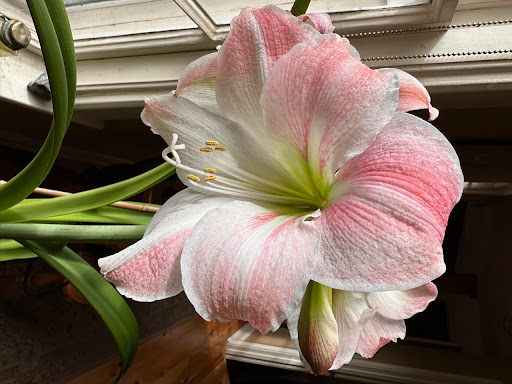So, who saw a monocot this week? I guarantee you all did, whether or not you were paying attention or taking my assignment seriously. I chose the orange daylily, Hemerocallis fulva, to introduce the subject because it has large flowers, is familiar to most readers, and is conspicuous at the Ames Free Library’s entrance. Yet, it’s easy to find other plants in this group. Monocots “comprise one-quarter of all flowering plant species” according to the University of California, Berkeley, and there are many of them: 60,000 - 70,000 species, depending on the source. Let’s consider a few more for practice.
One family you are sure to encounter is the grasses. Members of this large family have adapted to a range of sunny habitats including salt marshes, alpine meadows, and prairies.

North River, Marshfield, Massachusetts

Lassen Volcanic National Park, California

Badlands, South Dakota
In the right conditions, grass can be spectacular.

Switch Grass, Pembroke
At other times, it’s a little more subdued.

Lawn Grasses, Pembroke
Some ornamental monocots may be growing in your or your neighbors’ yards. These include lily of the valley, yucca, and hosta. Notice the elongated leaves with parallel (or almost parallel) veins.

Lily of the Valley, Pembroke

Yucca, Pembroke

Hosta, North Easton
If your garden contains a monocot in bloom, its flower parts will grow in multiples of three. Sometimes the arrangement is simple like the spiderwort’s blossom. The flowers of other plants, like the iris, are more ornate but still follow the pattern of threes.

Spiderwort, Pembroke

Blue Flag Iris, Wareham
Many monocotyledons, including cattails and pickerel weed, live in wetlands. Individual flowers on these plants are quite small and require a hand lens for close inspection. Always carry that hand lens!


Cattail, Hanson Pickerel Weed, Hanson
If you ventured into woodland, you might have seen the basal leaves of a well-loved orchid, the pink lady’ slipper, though its flower has long since faded. The orchid family has more species than any other family in the monocot group. They are especially diverse in the tropics. The Native Plant Trust lists twenty-four orchid species in Massachusetts, though some are very rare. I’ve seen almost half of them.

Pink Lady’s Slipper, North Easton
You may wonder how orchid flowers fit the “multiples of three” rule. Despite their sometimes flamboyant appearance, orchids have three sepals and three petals, but one of the petals is modified into a lip (labellum). The pink lady’s slipper’s lip is the inflated pouch that houses the flower’s sexual organs. This chart from the New York Botanical Garden illustrates the arrangement.
Perhaps the hot, humid weather got the better of you, and you stayed indoors. Guess what! Some people bring monocots inside their houses. If you own a palm, devil’s ivy, dragon tree, or amaryllis, you’re cultivating a monocot.

Dracaena marginata, Dragon Tree

Parallel Leaf Veins, Dragon Tree

Amaryllis
No space, time, or expertise for houseplants? Not a problem. You eat monocots . . . lots of them. Onions, garlic, pineapple, bananas, asparagus, coconuts, ginger, vanilla, and many more food plants are monocots.

Garlic Chives, Pembroke (Six petals per flower)
The world’s major crops, the grains, are monocots. If you ate a sandwich, muffin, pasta, oatmeal, or tortillas this week, then you digested some monocots.

Corn, Hanson
Why pay so much attention to everyday plants? It’s helpful to observe patterns of anatomy, habitat, and behavior when studying nature. Doing so can make a complex subject more manageable and lead to a deeper understanding. Learning to distinguish monocots from dicots is one step. Over the coming months, I intend to make botany more accessible by introducing plant families through common species. In the meantime, look closer at the familiar plants in your neighborhood. You’ll be surprised by what you see.